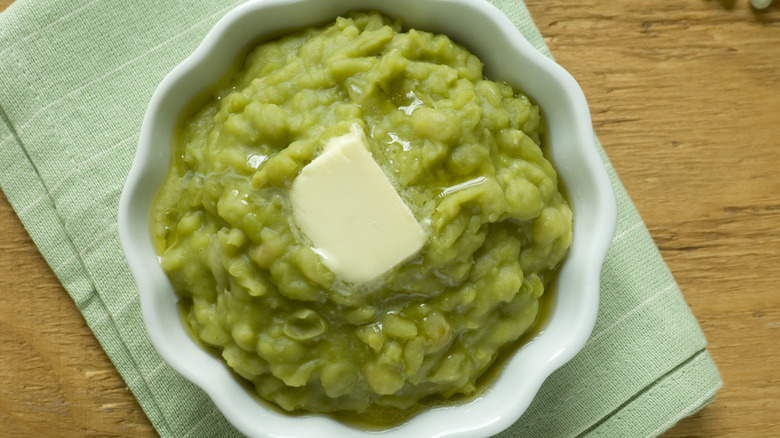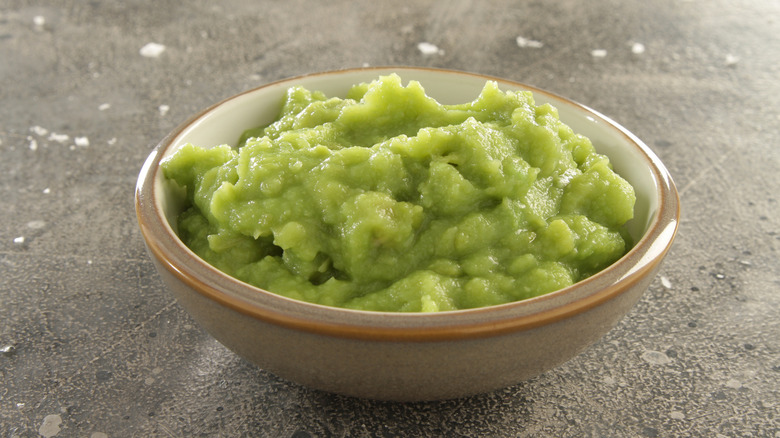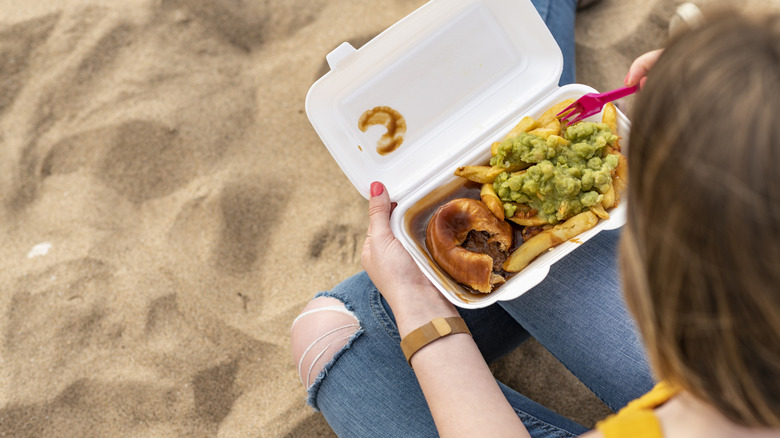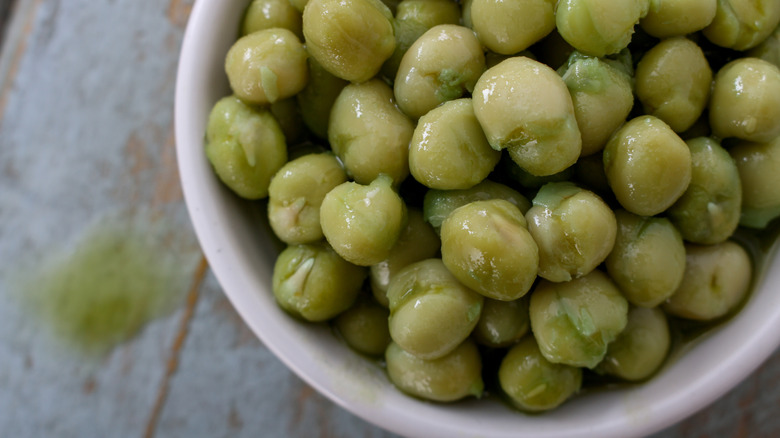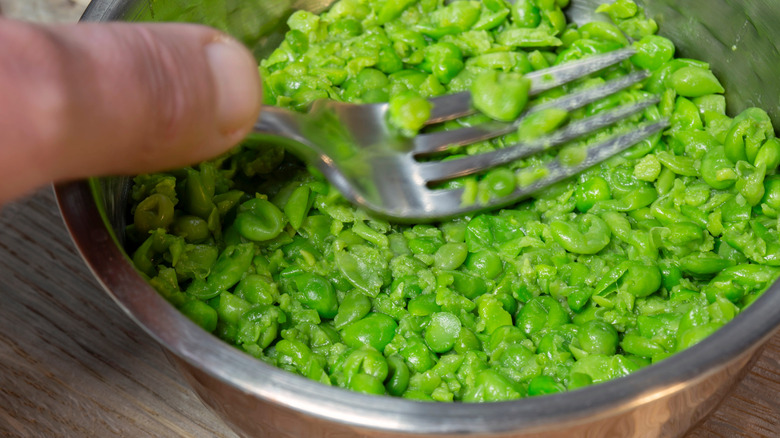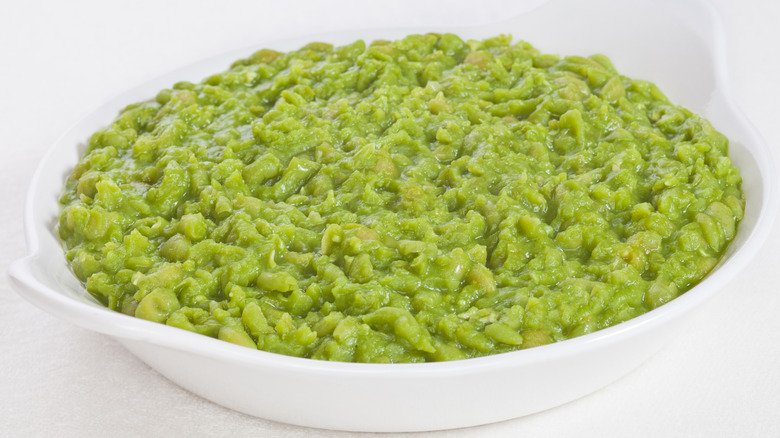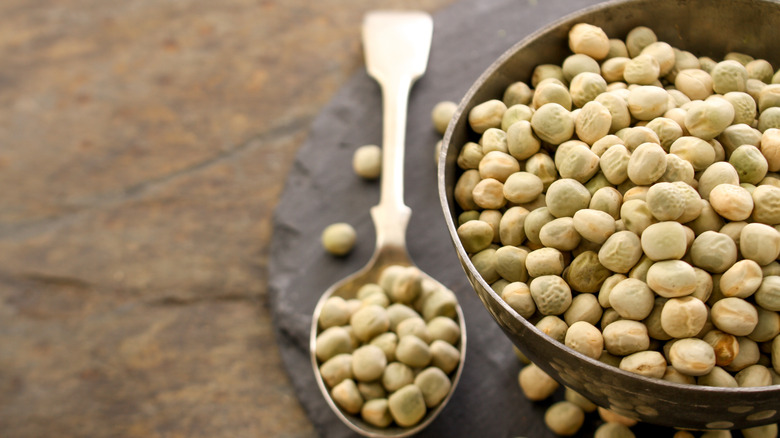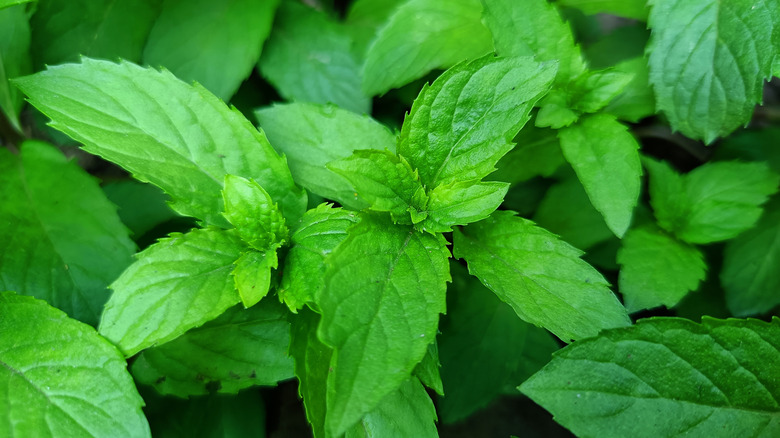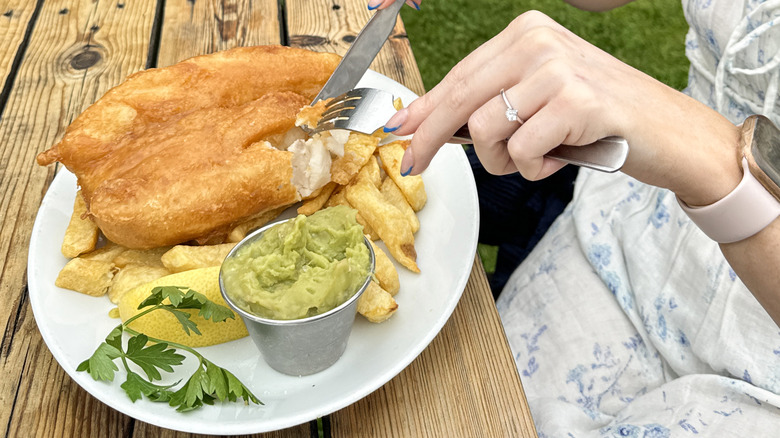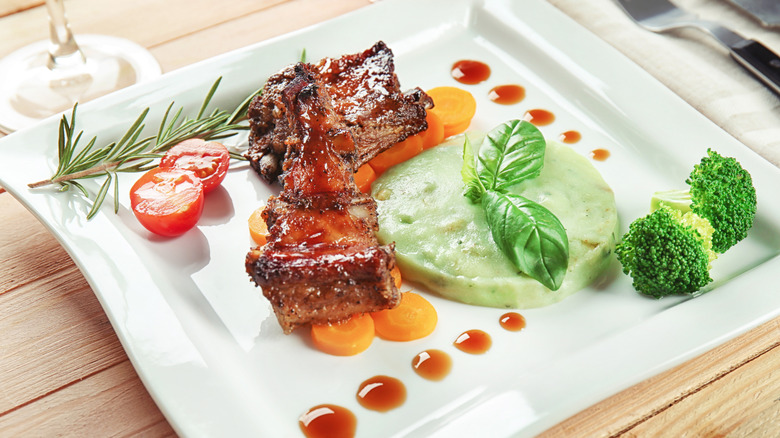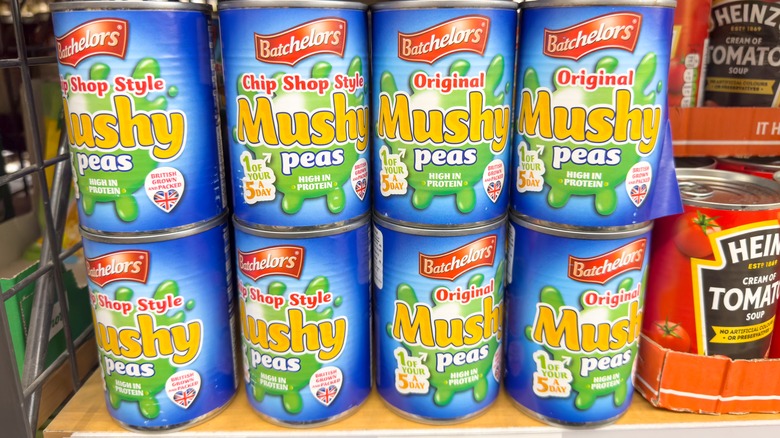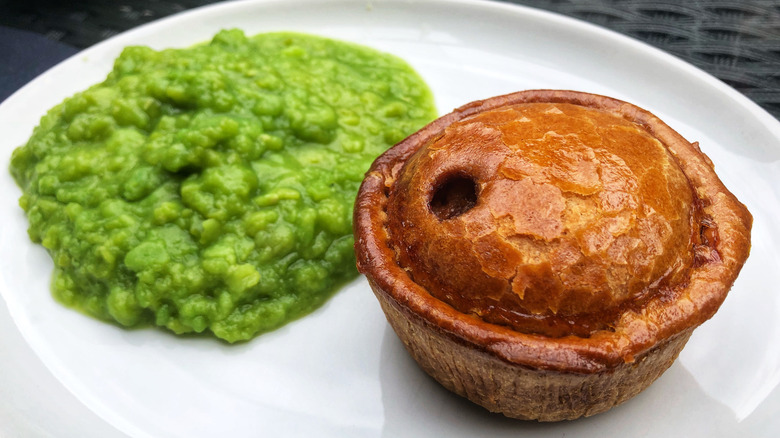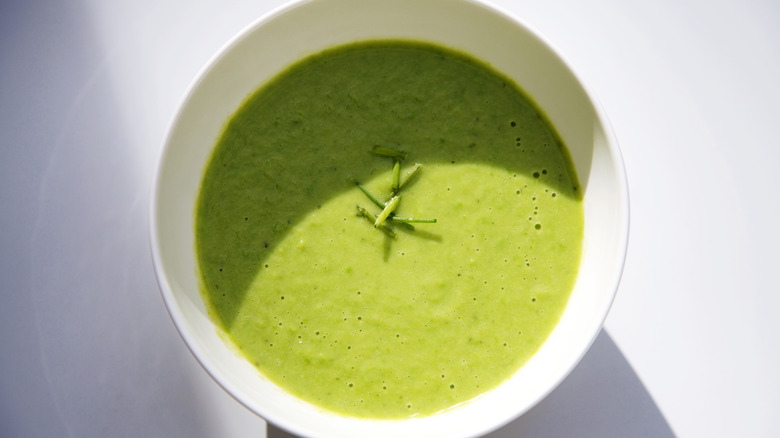What Are Mushy Peas And What Makes Them So Delicious?
The words mushy peas might not sound too appetizing but that's just because you haven't tried them yet. Anyone who's eaten this iconic dish has already seen the light. Those who haven't grown up with them or haven't yet tried them are probably left wondering what mushy peas are. And they definitely don't know the secret ingredient that improves them.
If you're still skeptical, I understand why but, with the greatest respect, you've got this one all wrong. I was born and raised in the U.K. and mushy peas are a cultural institution here. You can get a tub of them in every chippy — or fish and chip shop — and even small supermarkets sell them in cans. Despite admittedly looking a bit like something someone coughed up, mushy peas taste amazing.
They're technically a side, but their texture makes them more like a sauce for dipping chunky fries — or chips as they're known in Britain — and slathering over anything else on your plate. Now's the time when you're going to learn, honestly, more than you thought there was to know about mushy peas. You'll discover more about their history, what they're made from, how you cook them at home, what they're eaten with, and so much more. And if I convert one person to the wonders of mushy peas, my fellow Brits will be proud.
The history of mushy peas
While we don't know exactly where mushy peas came from, they're part of a larger tradition of peas in the culinary history of the U.K. Their significance comes from the fact that they grow well in Britain's temperate climate, store for a long time when dried, and are packed with protein and other nutrients. As such, peas became an important part of British diets, reaching back to medieval times and beyond.
Back then, they were particularly vital to the poorer members of society who needed cheap, nutritious food that was easy to grow. They were key ingredients in broths and pottages, and there's another traditional British dish called pease pudding, made from yellow split peas. So, peas have been a part of British diets for centuries, and when marrowfat peas started being cultivated in the 1700s, these became popular, too.
It's likely that marrowfat peas were used to make dishes similar to mushy peas for hundreds of years. However, it's unclear when they first became popular. Commercial packaged mushy peas were being sold as long ago as the early 1960s but this means they were likely made at home long before this, eventually becoming popular enough to warrant a packaged version. This dish is known as a side at fish and chip shops — the first ones sprung up in the 1800s. So, sometime between then and the mid-1900s, their popularity in chippies grew and spread until they became the unstoppable force they are today.
Mushy peas are popular enough in the U.K. to have their own day
When I tell Americans about mushy peas, I'm often met with the kind of expression usually reserved for Jell-O salads or ketchup on spaghetti. But in the U.K., we take our mushy peas seriously. So seriously, in fact, they have their own national day: November 9. Yup, we really have a day dedicated to a side dish that looks like baby food but tastes like a warm hug from your nan.
Okay, it's not exactly like Christmas and we certainly don't get the day off. It's more of one of those lesser-known food holidays like Pi Day or International Waffle Day (that's March 25, if anyone wants to buy me one in celebration). However, you may occasionally see some benefits from this special day. For instance, one year, 20,000 portions of mushy peas were given out for free in U.K schools. Plus, some restaurants might do mushy pea specials in honor of the big day. Peas — and mushy peas — have been an important part of our food heritage in the U.K. And that's why we give them their due with a whole day of appreciation.
Mushy peas are traditionally made using marrowfat peas
When talking about mushy peas, people often assume you simply take a bag of frozen green peas, cook them until they're soggy, and call it a day. But no, traditional mushy peas are made from something different: marrowfat peas. It's a simple distinction but an important one that makes a big difference in taste and texture.
Marrowfat peas aren't your garden-variety green peas. They're technically the same crop but a more mature version, left to dry naturally in the field. This extra time gives them a starchier quality that makes them perfect for soaking and slow-cooking into their signature mush. Regular green peas are fresher and more vibrant but this just isn't what you want from mushy versions.
What's brilliant about marrowfat peas is they come dried so you can use them in your own time. They've been popular for hundreds of years for their long shelf life — a real advantage in the days before fridge-freezers. They're great in mushy peas but they're also versatile; marrowfat peas are the same ones used to make wasabi peas.
So, if you want to make mushy peas, reach for the marrowfats. The trouble is, they're less readily available in the U.S. than they are in the U.K., where they grace every supermarket's shelves. But, let's not forget the marvel of the internet. It's not just for reading about mushy peas, you can use it to order obscure ingredients too.
You can use other types of peas but the results will be different
If you're curious enough to try making mushy peas at home, you've probably discovered how tough it is to find marrowfat peas in an American grocery store. While these starchy peas are the traditional base for mushy peas, as we've already discussed, you can technically make mushy peas with other types of peas. But they won't be quite the same.
Our traditional mushy peas recipe touches on a couple of options. Green peas are the obvious substitute. They're easy to find and have a fresh, sweet flavor that people love. When cooked down, they taste good enough but lack the thick, starchy consistency that marrowfats add to mushy peas. You've got yourself a tasty smashed pea side dish, but it isn't true mushy peas.
Then there are green split peas. These are field peas grown specifically for drying, so they're more similar in texture to marrowfat peas than regular fresh or frozen green peas are. They share that hearty starchiness, so the texture is more on point. The flavor, though, veers slightly earthier and less sweet. That's not necessarily a bad thing, it's just a little different.
If you want to give mushy peas a go without marrowfat peas, green split peas will give you more authentic texture. But if all you have are green peas, don't let that stop you from trying. At the end of the day, any pea's better than no pea when you've got fish and chips waiting.
How do you make mushy peas?
If you've never made mushy peas before, not only are you in for a real treat but you'll be pleased to know they're easy to whip up. The only thing you really need is time. Most of it's not active, but the peas need to soak so you have to decide in advance to make this dish. It's not just something you can throw together in half an hour. But homemade versions are so much more delicious than anything you can buy ready-made so it's absolutely worth it. And once you've mastered the technique, you'll wonder why you didn't start sooner.
The process begins with soaking the dried peas overnight. This step is non-negotiable — it partially rehydrates them and softens their outer skins, so they can become creamy when cooked. After a long soak, the peas are drained, rinsed, and simmered gently in fresh water until soft. It's a process that requires patience, not precision. Stir occasionally to stop them from sticking, and don't be alarmed if things start to look a bit gloopy. That's what you want. It should take around 30 minutes but don't be afraid to simmer them for longer if they need it.
Once the peas are falling apart, it's time to season them. Then, all that's left is a quick mash with a fork or potato masher. But note that you're not after a smooth purée here. You want a rustic, chunky texture. And that's it. You've made mushy peas.
What's the secret ingredient in mushy peas?
If you've ever wondered how mushy peas achieve that signature creamy texture, it's all down to a secret ingredient. Or, maybe not so secret, if you pay attention. These peas just need a bit of baking soda. It's the same stuff you use in cakes but here it's not used as a raising agent.
When you soak your dried marrowfat peas overnight, adding a teaspoon or so of baking soda to the water helps to soften their tough outer skins. This lets them break down more easily during cooking, so they get that velvety, spoonable texture we know and love. Without it, you're likely to end up with something chunkier and less mashable. Or you'll need to cook your peas several times as long to get the same texture. An added bonus is that it helps the peas keep their color so they're more green than beige when cooked.
But it's essential that you rinse the peas thoroughly before cooking. Baking soda might work wonders for mushy peas but it doesn't taste great. Failing to rinse it off can leave the finished dish with a mildly soapy taste and nobody needs that ruining their dinner.
How are mushy peas seasoned?
Less is more when seasoning mushy peas. You want those marvellous marrowfats to have their day in the sun. So, this dish doesn't need a whole heap of spices or a heavy hand with the cream. A simple sprinkle of salt and pepper does the job, and maybe a little pinch of sugar for added sweetness.
That said, I'm not above a bit of embellishment. A bit of finely chopped mint stirred through at the end of cooking is a touch that I'm always here for. Plus, a squeeze of lemon can add some brightness that's sometimes needed to balance out the one-note nature of the peas. I can also get behind a small knob of butter being added to the cooked peas. But you shouldn't be adding milk or heavy cream. The creaminess comes from the peas themselves, so any cream-containing recipe is one you should avoid.
Of course, there's always someone who thinks mushy peas are boring. Well, that's part of their charm. This isn't a richly spiced curry or complex French cuisine. It's just reliable old mushy peas, always there as a comforting side for a range of meals.
What do mushy peas taste like?
One of the most common things that people ask when I wax lyrical over mushy peas — which I do more often than I'd like to admit — is "what do mushy peas taste like?" The short answer is "peas" but we can do better than that.
Marrowfat peas have a deeper earthier flavor than standard green peas. They still have a slight sweetness to them, but they're not as fresh or bright as garden peas. Then you have the flavors from any seasonings you use. The slight kick of pepper, a zingy sweetness from mint, and a tartness from a squeeze of lemon juice.
But mushy peas aren't just about the flavor. Otherwise it would be easier to just eat plain marrowfat peas, which taste the same. Really, a big part of the enjoyment of eating them comes from the texture. "Mushy" doesn't sound all that appetizing. Creamy is perhaps more accurate. They're a bit like a chunkier version of mashed potatoes, mostly smooth but with some lumpier parts of peas. The texture and the earthy pea flavor come together to make something way more delicious than it sounds. You'll just have to try them.
Gourmet variations on classic mushy peas
There are some unexpected ways to use peas but making mushy peas isn't one of them. Still, if you want to step outside the normal confines of this basic side, there are various ways to level up mushy peas. In fact, in recent years, this British classic has had something of a glow-up, appearing on menus in gourmet guises that would make your nan raise an eyebrow.
If you're looking for an international twist, adding a tablespoon or so of harissa to a portion of mushy peas is an easy adaptation. Spicy and flavorful, this pepper-based paste is full of herbs and spices that instantly transform the dish. Other people make posh versions of mushy peas with petit pois in place of marrowfat peas, yogurt for creaminess, and garlic for some extra flavor.
Adding truffle oil is another gourmet variation. It might seem like overkill for a salt-of-the-earth mushy pea but, shockingly, it kind of works. The truffle's umami richness pairs well with the peas' natural sweetness. You can also toss in alternative fresh herbs like tarragon or dill. These bring variations on the flavor that you don't get from mint and can make a nice change.
You can buy mushy peas ready-made in the U.K.
One of the great conveniences of life in the U.K. is that mushy peas are always within arm's reach. Pop into any supermarket, and you'll find them ready to heat and eat. Canned versions are the most popular, with original and chip shop style both available. I've never been able to work out the difference between the two, though not for lack of trying. But you'll also occasionally spot them frozen or even tucked into the chilled section. Want mushy peas with dinner but don't feel like soaking and simmering? Well, that's no problem. Just heat them up and you can have them on the table in minutes.
But if you're in the U.S., things get a bit trickier. Mushy peas are something you have to work for. They're not on the shelves of your average grocery store. Sure, you might occasionally be able to find them online or in British specialty stores, but don't think you can head to Walmart or Kroger and pick up a can. However, if you decide to make mushy peas from scratch that makes you a true fan. You care about them enough to go to the effort of making them from nothing but a bag of dried marrowfat peas. And, honestly the supermarket versions don't compare to homemade ones, anyway.
Mushy peas are often served with fish and chips but that's not the only way
The national dish of the U.K. is pretty much fish and chips, and mushy peas go with this classic like PB&J. Though, you probably want to keep the peanut butter and jelly out of the equation when it comes to this dish. It's one of Gordon Ramsay's favorite comfort foods – and he's even shared recipes for battered fish with mushy peas to go alongside it. You won't find a chip shop in the land that doesn't sell mushy peas in little styrofoam cups to go with your meal.
Eating fish, chips, and mushy peas is not the only way to enjoy this side. Mushy peas are also great with savory pies or with the oddly named British dish that is bangers and mash. Some people like to put them in a sandwich with fish fingers – or fish sticks as they're known in America. They're actually quite a versatile side. If you're serving something that you'd eat regular peas with on the side, you can most likely reach for the mushy version instead.
You can use mushy peas in various recipes
Mushy peas don't have to be relegated to life as a side dish. You can also use them as an ingredient in other recipes. This gives you more ways to enjoy them or some creative ways to use up any leftovers. In fact, you should probably make extra just so you can use them in other recipes.
Perhaps the best thing to come out of the U.K. — except for me — is the mushy pea fritter. They consist of little discs of mushy peas, battered and fried. The discs are frozen to make it possible to batter them and then they're thrown in the fryer. You can find them in chippies all over Britain and they're possibly the best food ever.
You can also cook mushy peas into pies. They can be the only filling, if you're as obsessed as I am, or you can mix them or layer them with other ingredients. Mushrooms go particularly well with mushy peas for a tasty veggie main. Another option is to use them as a topping for dishes like shepherd's pie or fish pie that usually have a mashed potato topping. A totally different kind of pie but a delicious one nonetheless. Or you could repurpose any leftover peas into a soup.
However, you don't just have to go for traditional options. You can go out there and make mushy pea curries or mushy pea pasta dishes. Yes, they're unconventional but there are few things mushy peas can't do.
